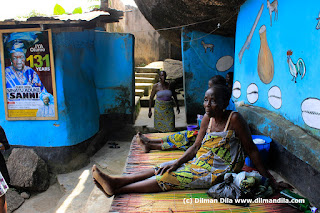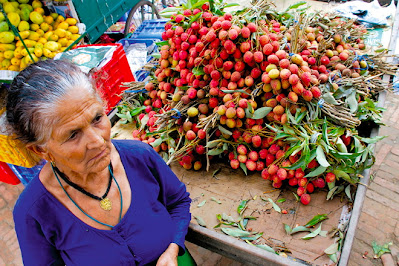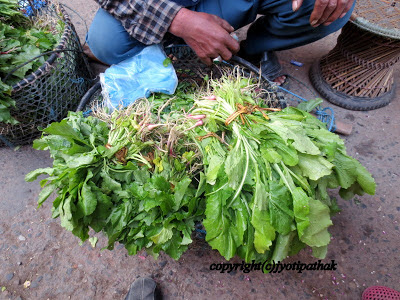I've been to a few caves before, some that human ancestors inhabited two million years ago, but the caves in Olumo rock blew me away. Historically, it's similar to Lamogi Hills in Gulu, which locals used as a base to fight British colonialists, and the locals were only defeated after the British poisoned their drinking water. In Olumo rock, locals found a refuge against enemy attacks, but they went a step further and built mud walls to create rooms within the caves, thus turning the caves into homes. To this day, caretaker families live in these caves, and some chambers are still used for ritual worship, which makes it much more than just a tourist site, the kind of place I like to visit.  |
| One of the caretakers, and spiritual priestess, who lives in Olumo rock |
I saw spots marked with red and white flags, where sacrifice is made. The flags got me thinking, for they reminded me of the Hindu and Budhist temples in Nepal, the beautiful country, tourist based country, , the beautiful country, tourist based country, , which also had red and white flags in places of worship. When I visited the Legio Maria sect in Kenya, I saw similar prayer flags, and it got me thinking, what is the significance of these flags? It is something I have to look into.
After visiting Olumo rock, I knew I was in for a real treat in Nigeria, for my mission was to see real historic monuments, structures that predated colonialism, but not those that are in every tour guide. Olumo rock was the most famous of the places I visited.
 |
| Fascinating Mud houses built in the caves. |
My next stop was in Irefin palace. If you have not read my previous post, please do before visiting this place, for it is a live site. People live in there, and they are not caretakers like those in Olumo, but the families that have occupied the building for dozens of years. They are a bit squeamish about visitors popping out of nowhere to take photos and tour the place. They would not let me in, because I had not pre-booked, because no one had told the caretaker chief that I was coming, and because I carried a black backpack and because I looked like a Hausa from Nothern Nigeria, hence I was mistaken for a Boko Haram agent. The strange thing is that no website ever mentioned anything about booking in advance. I learnt the heard way. The best place to start is the National Council of Museums and Monuments. What fascinated me about Irefin was the architecture. It's mostly of wood, a storeyed structure, about two hundred years old, but I could see European influence in it, or more accurately, it is similar to the buildings freed folk set up once they returned from America. I've seen similar buildings in photos of Freetown. It was not quiet what I was looking for. Still, I found the area around the palace to be of greater interest, for there are dozens of buildings with fascinating architecture, and I could have spent the whole day just taking pictures of them, or trying to discover more about them. Sadly, security people mistook me for a terrorist rece-ing the place, and I had to cut short my visit. You can read about that here.  |
| Scenic. Idanre town in Nigeria. Totally worth a visit. |
Idanre turned out to be the most interesting place I have visited in a long time. It's not as old as Akure, but certainly older than Irefin, and the people who first settled there chose a plateau on top of a rock, accessible only by one path. This was for security reasons, as it is virtually impossible to attack the place up there.
The best part about it is getting there. I went up over six hundred steps curved into the stone steep, and when I got there I thought I would find the ancient palace right away, but no, we had to trek through a mini-forest, which might have been a jungle in ancient times, past a grassland, past huge boulders that stood on our way. I got the feeling that I was a real explorer, going through the wilderness in search of lost cities and pre-historic palaces. This hard to access location gives Idanre an exciting and adventurous character, for modern day civilization is yet to encroach upon the plateau. You can see signs of it, on the graffiti people scratch on the walls, but when you are up there you get a feeling that you have walked right into the past in some kind of time machine. You don't hear urban noise, or see anything 'modern looking'; you catch a real glimpse of what life might have been like over a hundred years ago.
The village is still settled. Until the late 1970s, the village was still very much alive, but now only a handful of people stay up there to farm it. They however fully use the palace for some rituals and sacrifices. A lot of the old buildings have been preserved from the way they were a hundred or more years ago. There's the court house, the prison, the royal burial ground, a rich man's homestead – marked by the number of animal skulls that hung from the eaves of his houses. Not just the number but the type of skulls, the animals he ate. Just as animal skin was a symbol of wealth or power, (for example only a warrior who has killed a leopard would wear leopard skin, in some communities), the types of animal skulls on the eaves showed what kind of meat the household ate, and how much.Check out my YouTube Channel for great films!
Skulls served another purpose, as some kind of bone calendar. One of the falsities pumped into our brains in the colonial-influenced schools we attend is that Africans did not record the passage of time. I have a whole argument against this, but seeing the bone calendar in the palace of Idanre opened my eyes. Skulls were piled in one corner of the courtyard. According to the guide, at the end of every year the king held a feast/ritual, a bull (or some such animal) was slaughtered, and its skull kept in that corner. At the end of his rule, the number of skulls in the corner would indicate how long he ruled. In the much older palace at Akure, there were skulls in several rooms, each room belonging to a king/oba and recorded how long that particular king ruled. |
| Skulls of wild game hung from the eaves of a rich man's house. |
 |
| A skull in a pile that forms the 'bone calendar' in Idanre palace. |
Trekking through the ancient village raised my appetite to see the palace, but when I eventually saw the palace, I got a feeling of 'Is this it?' After the long hike up the steeps, after plodding through forests and jumping over streams and crossing boulder-filled bushes and feeling like a true explorer, I expected something grand, something to match the hype of a village that has stood for hundreds of years. But it's a mud house, after all, and I shouldn't have expected anything grandiose. I should have only looked forward to the experience of being there, of seeing it, of touching it. As they say, it's not the end of the journey that matters, but the journey itself. It was a worthwhile experience, and I would recommend a visit.
 |
Weird rules in Idanre, a house just outside palace.
- Nobody should wear clothes inside this house.
- Shaking of hands is forbidden here
- Carrying of loads on head without holding it is forbidden
|
The next day when I set off for another ancient palace in Akure, I did not expect to see grand structures, but rather to experience an architecture that has survived for nearly a thousand years. The palace was first built in the 1100s AD, and it has stood for all these years. Again, like in Irefin, I had trouble getting in, because the gatekeepers said I did not have a 'document' allowing me to visit the palace. They did not know where I could have gotten this document, or what it looked like, but they thought I needed a letter introducing me to them, and my purposes there. I almost failed to see it, until I went to the neighboring building, a museum, where I found staff of the National Council of Museums and Monuments. The staff were appalled that the security people had failed to see me as a genuine visitor, and they smuggled me into the palace for a secret tour.
It is still an active site, with some of the courtyards inhabited by the widows of the late kings, and maybe that is why they are cautious about letting people walk in unannounced, but they should have stated that in their websites.
For a moment, as I toured the palace, I kept asking myself, what is all the bother about? Do I really want to see a collection of mud walls and dark rooms so bad that I have a shouting match with 'security' people for nearly thirty minutes? When we started to go through the palace, I knew why it was worth the bother. The palace is like a maze of sorts. It has over twenty courtyards, with some courtyards being inside courtyards, we had to keep consulting a map otherwise we could have gotten lost.
One fascinating courtyard is the stuff of legends. It is said that even if a thousand people peed in this courtyard, it would not smell. Christian Odutola, an architect who acted as my guide, had no explanation for this phenomenon. He thought they used a type of soil, or maybe a chemical that absorbs the urine and smell, to make the courtyard.
He however was full of praise for the drainage system in the palace. In its thousand years of existence, it has never experienced flooding, compare that to the incessant floods in many African cities today which are a result of poor planning. Of course, the palace is so small a place it can't be compared to a city, but still, it has over twenty courtyards, with courtyards being inside courtyards, and thus the designers needed a drainage system that would ensure the inside courtyards never flooded.
Also, they built it in such a way that there is enough sunlight in every courtyard, or enough sunlight to see by. It reminded me of the German Bundestag in Berlin, which was also built with care taken to minimize artificial lighting. When you take these little details into account, you realize that Akure palace is a work of sheer genius.
 |
| Clever architecture allows natural light into every courtyard, Akure palace. |
 |
| An aerial view of Akure old palace |
Unfortunately, it's crumbling, and the current governments are not doing enough to preserve it. I think after they built the new palace, they forgot this. Some parts of the walls that have fallen away, and they have replaced it with concrete, which I think is not a good idea. Christian Odutola also thinks it is a very good idea. He is working with the NCMM to preserve the palace as it has been in the last a thousand years, and if the structure has withstood the test of time, there is little point in trying out new materials that might be tricky maintaining in the long run. Besides, using cement waters down the historic value of the walls that have stood the test of time.
The problem is they do not have enough funds to maintain the place as it has always been, and are lobbying UNESCO declare it a world heritage site (along with the palace in Idanre), then maybe it will attract enough attention and funding to keep it running, and to maintain this ancient genius artwork.
 |
The wife of a former chief takes shelter from the midday heat
in one of the courtyards, Akure palace |
 |
| Exploring the ancient, abandoned village in Idanre |
 |
A woman prepares a meal in Irefin palace.
|
 |
Preparing to face the six hundred steps to the ancient village of Idanre.
In the past, there was no steps, just a path up the steep cliffside |
 |
| Life inside Irefin palace, Ibadan. |
You Might Also Like



.jpg)

















Comments
Post a Comment